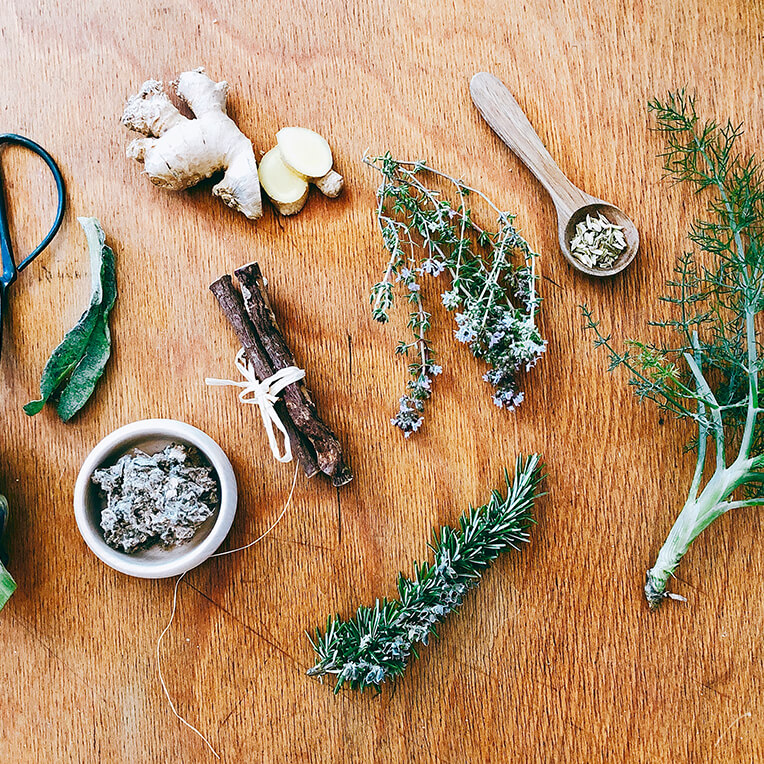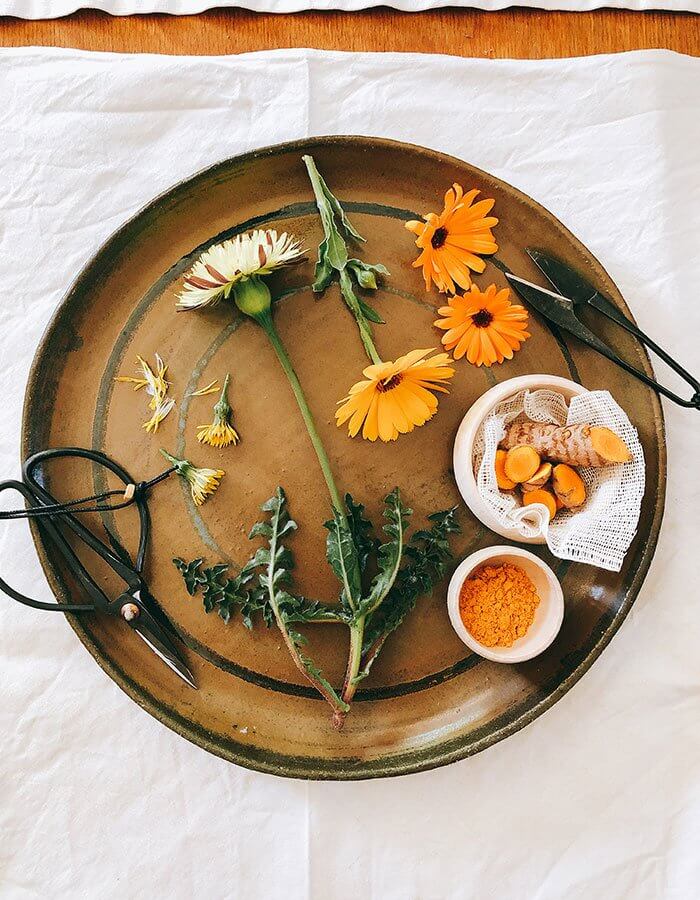Recipes »The Power of Medicinal Plants Part 3«
In sisterMAG No. 49 and No. 50, we introduced you to the first two parts of the »The Power of Medicinal Plants« feature, which deals with question of what we can do for our bodies to put it in balance, and how medicinal plants can help us thereby. The final part of the feature by Sandy Neumann is dedicated to the big topic »digestion«. Find here interesting information on the subject of the digestive system and some great recipes that can help you to improve your digestion and make you feel better. Download the whole feature including recipes here for free.
- Recipes & Text : Sandy Neumann
Digestion
In recent years, there has been sufficient research and new knowledge about our digestive tract and all its functions. The digestive system is fundamental to our body and has an immense influence on our physical, mental, and spiritual health. It is for good reason that the stomach is also called our second brain or abdominal brain. It, too, has millions of nerve cells. A multitude of well-known idioms like “I felt that in my stomach” show what happens to us when our digestion does not work and how far-reaching the effects can be.
The upper digestive tract is the gate where healthy digestion begins. Always remember to chew well! my great-grandmother used the ” chew 30 times before swallowing rule”. We all certainly catch ourselves gulping down our food from time to time. Our digestion actually begins before our teeth, enzymes, and stomach acid become active. The sight of a tasty meal or simply one’s imagination is enough to trigger our classical conditioning and set the salivary flow in motion. Stress prevents this. This is where bitter taste is our friend. Many herbs help for a good digestion and protect against acid reflux, heartburn, bloating, and a feeling of fullness. Calming herbs for a stressed stomach help when too much was difficult to digest.
The lower digestive tract is our control centre for the absorption of nutrients, degradation, and excretion. Good gut flora with beneficial bacteria is essential and helps activate intestinal peristalsis, counteract inflammatory processes, strengthen the immune system, and ward off diseases. A diet rich in beneficial bacteria such as fermented foods (sauerkraut, kimchi, yoghurt) is not only tasty but also a great asset to your health.
In the case of flatulence, gases, and pain – often associated with harmful bacteria, unfavourable eating habits, allergies, stress, and intestinal diseases – it is important to gradually integrate beneficial foods and herbs into your diet. Many herbs can relieve flatulence and gases, have an antispasmodic effect, and simply taste delicious.
Qualities: digestive, bitter, antispasmodic
Artichoke – Cynara scolymus
Many people are scared away by artichokes. On the one hand, they probably don’t know how to prepare the plant in the kitchen. On the other, it could be due to the bitterness of the leaves from which the extract is extracted. The artichoke is a masterly medicinal plant when it comes to boosting our digestive system and protecting the liver.
The plant belongs to the thistle family and was scrawled on the walls of Egyptian pharaoh tombs. In the 16th century they were used as a remedy against jaundice, and as an aphrodisiac. Artichokes are cultivated mainly in the south of France, central Italy, and in moderate-mild regions of the Atlantic coast.
Rich in vitamin C, vitamin E, beta-carotene and a multitude of minerals and trace elements, it is a plant with utmost value to your well-being. Calcium protects the bones while magnesium shields from stress and allows us to better tolerate psychological demands.
Cynarin, the artichoke’s bitter substance, promotes bile flow and digestion, as well as the removal and excretion of harmful substances. Leaf extract in particular contains substances that fight free radicals. Recent research results indicate that both the artichoke itself and its leaves have a beneficial effect on arteriosclerosis and elevated blood lipid levels. Furthermore, artichokes have been shown to lower cholesterol levels.
In the kitchen it is important not to cook artichokes for too long. The shorter the preparation time, the better its digestion. Breastfeeding mothers should refrain from consuming artichokes as they have an unfavourable effect on the secretion of milk.
Dried artichoke leaves as an extract are a great start to the morning. In the evening, let 1 teaspoon of artichoke leaves steep in 150 ml cold water. Then simply strain and drink. It is very bitter but after a few days it is a wonderful morning elixir.
Fennel – Foeniculum vulgare
Fennel is truly versatile. The bulb, foliage, and seeds can all be used. Located in the Mediterranean region, fennel has been popular since ancient times and has not only made a triumphant march through Europe, but can also be found in Japan and South America. Used for more than 5000 years, fennel strengthens the stomach and is effective against flatulence and bloating. Chewing the seeds can provide immediate relief.
Many know the mixture of fennel, aniseed, and caraway as a tea for small children as nursing mothers appreciate the stimulating effect on the flow of breast milk. Modern naturopathy usually makes use of seeds. The healing properties come from the essential oils, including the highly effective anethole, which is antispasmodic, expectorant, and antibacterial. Fennel belongs to the umbellifers and is related to dill, anise, and caraway.
Of course, fennel is also a plant that can enrich our diet. The bulb can be consumed raw, roasted, cooked, or grilled, while seeds give biscuits and spice cakes a special touch and are a wonderful aroma for fish and meat. And never throw away the leaves. The delicate stems refine any salad and are perfect as a garnish for soup.
Licorice root – Glycyrrhiza glabra
The juice of the liquorice root is used to produce what we more commonly known as liquorice. Unfortunately, nowadays flour is often simply mixed with anise and then called liquorice.
The dried roots of liquorice, which belongs to the legume genus, have a healing effect on gastritis and stomach ulcers and help with heartburn.
Liquorice most likely has its roots in southwest Asia; records prove that it was cultivated from the beginning of the 16th century until the 1950s in the Bamberg area. The plant supposedly belonged to the equipment of Roman soldiers. Chewing was supposed to suppress thirst and hunger. The plant was supposedly a component of Roman soldiers’ equipment. In the Middle Ages the root was prepared as tea or cooked in wine and used to remedy urinary and kidney ailments.
Liquorice is of great importance in modern naturopathy. The contained glycyrrhizin has an anti-inflammatory effect. Other substances have an antispasmodic and expectorant effect. A tea made of liquorice, peppermint, and lemon balm helps against a variety of digestive complications. So-called medical liquorice is eaten to provide relief for alcohol-induced headaches and stomach issues.
Liquorice should not be eaten during pregnancy as it stimulates the function of the adrenal cortex and increases the release of cortisol. One should consult a doctor for heart and kidney problems, as liquorice stimulates urine production.
Bouquet Garni
A bouquet garni is a wonderful way to bring some Mediterranean flair to the table and dishes, as well as to do something good for the body. You’ll need stems of rosemary, thyme, and lavender, and leaves of sage and laurel. The bouquet seasons soups and stews Since it is tied together, it can be easily removed after cooking. Fresh or dried, it also looks lovely as a decoration.
The proportions depend on the personal taste.
Recommended for a bouquet garni:
- 2-3 stems thyme
- 1 stalk rosemary
- 1 stalk lavender
- 2 sage leaves
- 1 bay leaf
Tie the stems together with a ribbon or kitchen thread. Make plenty of it in the summer, dry it, and then keep it airtight in a container. Alternatively, bind and use fresh bouquets.
Galette with fennel, feta and egg
for 4 servings
for the galettes:
- 220 g buckwheat flour
- 1 egg
- 1 pinch of salt
- 500 ml water
- oil for frying
- 2 bulbs fennel
- salt, pepper
- olive oil
- juice of a lemon
- 200 g feta
- 4 eggs
- oil for frying
For the galette dough, place the flour in a bowl. Form a small hollow, add the salt and the egg, and mix with a fork. Gradually add the water and mix to a smooth dough. Let stand for 1 hour.
Wash, dry, and finely chop the fennel. Use the fennel green in any case, as it is particularly aromatic. Mix with a little salt and let stand for 20 minutes. Then mix olive oil and lemon juice and add to the fennel. Season with pepper.
Fry the eggs in a pan with a little oil. Set aside.
Add some oil to the pan for the galettes. Take a ladle of dough and put it in the pan. Fry on both sides.
To serve, cover 1 galette with fennel salad. Sprinkle some feta and put the fried egg on top.
Medicinal tea
for 500 ml tea
- 1 stick liquorice root
- 1 stick cinnamon
- 5 cardamom capsules
- 1 sprig fresh peppermint
- Petals of 2-3 Calendula flowers
Bring herbs and spices to a boil in 500 ml water and simmer for 25 minutes at very low heat. Pour through a sieve and enjoy one sip after another. Also tastes great in summer.
DETOX
“Cleaning and tidying up” – this is also important for our body and is often overlooked by conventional medicine. Naturopathy and homeopathy users know about the healing and beneficial effects of fasting and a lifestyle that helps to support our organs, for example. Many disease patterns are associated with suboptimal organ detoxification, including asthma, migraines, autoimmune diseases, and skin diseases such as neurodermatitis and acne.
The liver is a real power station, and bitter herbs are a blessing to support it. It doesn’t take an overhauled diet to incorporate green vegetables, wild herbs, and into your life. The result is protection for the liver as well as the removal of toxins and purification of blood.
Lymph and skin also need a clean-up. Toxins are transported via the lymphatic fluid, and immune cells are found in the lymph nodes to ensure the transport of substances. Lymph fluid moves through the body but is not actively “pumped”. This is supported by massages, dry brushing of the skin, sauna visits, and herbs.
Qualities: bitter, detoxifying, purifying
Dandelion – Taraxacum officinale
It may be hard to believe, but what gardeners so often want to fight in their oasis is a real superstar to promote detoxification. Rich in bitter substances, dandelion is a recognized medicinal herb that helps combat liver and gall problems. It belongs to the group of composite flowers and has its origin in the northern hemisphere. It spreads almost everywhere on its own – even wall cracks are not too narrow for an outburst. Dandelion leaves, roots, flowers can all be used as a great source of vitamin C, best used fresh. The leaves, together with other wild herbs, are a real delicacy. Dandelion offers a special tangy, spicy, bitter taste and a nice change for the standard salad. The leaves contain a high concentration of iron and calcium while the yellow flowers are rich in carotenoids.
Dandelion has long been known as a medicinal plant and supports the healing of many ailments. It helps the liver remove harmful substances and produce bile, as well as having a dehydrating effect in supporting the kidneys. In French, dandelion is called pissinlit, which means “peeing in bed” because it is a diuretic.
In addition to bitter substances, dandelion also contains substances to remedy skin allergies, excesses, and impurities.
Turmeric – Curcuma longa
Also known as yellow ginger, turmeric has been of great importance in traditional ayurvedic and Chinese medicine for thousands of years. The small root is now receiving increasing attention and its healing powers are used in numerous ailments. For example, turmeric as an anti-inflammatory, antioxidant and even painkiller can help with rheumatoid arthritis and osteoarthritis. Turmeric acts as a blood thinner, improves blood circulation, protects against heart disease, helps in the treatment of depression, and promotes digestion.
Its distinctive curcuma-yellow colour is also used for food colouring. One should be careful when using turmeric as it has a tendency to stain the skin and clothing. Turmeric is hardly soluble in water and is difficult to absorb in the intestine, so it is a good idea to add some black pepper. You can also combine it with fat, like an oil, to aid its absorption by the body.
Marigold – Calendula officinalis
Marigold is a very old medicinal plant native to southern Europe and the Mediterranean region. It was probably already used by the Egyptians and important enough to serve as a burial gift in Pharaonic tombs.
The marigold was likely also used as a medicinal plant in ancient Greece. Ancient writings mention a plant called Klymenon, which is described in similar terms as a marigold. It was used to treat injuries and burns. In ancient Rome, a plant called Caltha flaventia lumina, which likens to marigold, was used to treat injuries.
Hildegard von Bingen used marigold under the name Ringula internally to fight digestive disorders and poisoning and externally in an ointment against eczema. Marigold is mainly used externally, as an ointment, because of its ability to speed up the healing of wounds. Moist compresses of boiled marigold can provide relief for sprains, poorly healing wounds as well as fresh wounds, and inflammatory forms of acne. The effect of marigold has also been medically proven to be effective against cuts, bruises and burns, as well as inflammation of the mucous membranes. Internally, an infusion of flowers cleanses the blood and relieves menstrual symptoms.
Dandelion macadamia pesto
- 1 handful of dandelion leaves, sliced
- 150 g macadamia nuts, chopped
- 100 g grated Parmesan cheese
- 1 clove of garlic, finely chopped
- 150 ml olive oil
- 1 dash of lemon juice
Process all ingredients in a food processor until it becomes a smooth paste. It tastes delicious with cottage cheese and a slice of baguette and as a great alternative to classic pesto. It keeps in the fridge for two days.
Marigold massage bar
for 6 massage bars
The marigold oil can be easily produced on your own. For this, add 80 g of dried marigold flowers (dried by yourself or bought) to 100 ml jojoba oil and leave in a glass for 2 weeks in a sunny place. A small glass weight will ensure that the flowers do not come to the surface. Shake daily. After 2 weeks, pour everything through a sieve.
The oil can be used for a maximum of 1 year. The faster you use it, the better. The oil is very suitable for healing; beeswax can be used to make a healing balm for small wounds.
It is recommended to use silicone moulds for continuous production. They are very practical, easy to clean, and allow for the safe removal of soap pieces.
Ingredients:
- 500 g goat’s milk raw soap
- 4 tbsp marigold oil
- 20 drops orange oil
- 4 tbsp coriander seed
- 50 g dried marigold blossoms
Melt the soap base in a water bath. Do not heat above 72 degrees Celsius, otherwise the soap base will turn yellow and dehydrate. Then stir in the oils and coriander seed. Carefully pour into the moulds. Sprinkle some marigold over it. Cool for 3-4 hour and allow to set. Then remove from the mould.
ATTENTION: These recommendations and taking herbs does not substitute going to the doctor and must be considered at your own risk. The author assumes no liability. Furthermore, there is no claim of complete accuracy.



 Ingredients:
Ingredients: